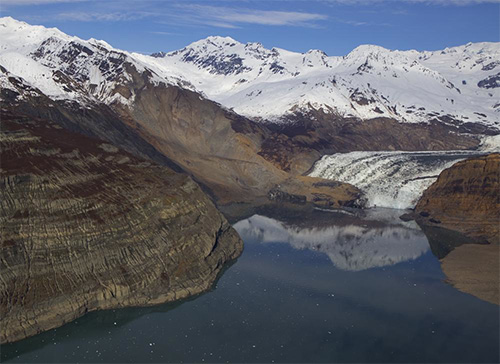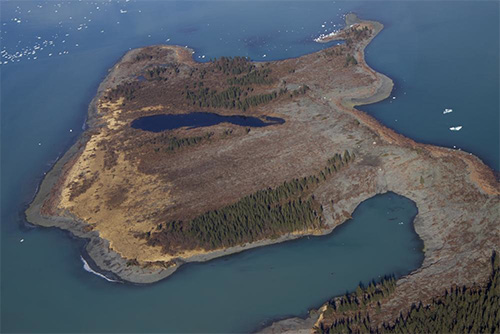
Alaska Science The giant wave of Icy BayBy NED ROZELL
April 11, 2016
After a period of heavy rains, a mountainside near Tyndall Glacier collapsed into a fiord of Icy Bay on October 17, 2015. The displaced water generated a wave that sheared alders more than 500 feet up on a hillside across from the slide. To put that in perspective, the 2011 tsunami in Japan reached about 130 feet above sea level. The Icy Bay wave may be the largest since a magnitude 8 earthquake shook much of a mountain into Lituya Bay in 1958. The wave that followed ripped spruce from 1,700 feet up a mountain slope and left trimlines in the bay that are visible today.
The site of an October 2015 landslide in Taan Fiord, within Icy Bay.
Winter snows hid the extent of the wave generated from the rock avalanche. Upon hearing a report from a pilot colleague that the landslide area of Icy Bay was free of snow, glaciologist Chris Larsen flew there in his Cessna 180 from his home in Fairbanks. The Geophysical Institute professor used a camera system mounted in his plane to make a high resolution map of the landslide and the path of the megatsunami. "It almost blows away everything in the historical record except for Lituya Bay," he said. "It's really a unique event to have a tsunami 100 meters high." The landslide dumped rocks and soil into a finger of Icy Bay known as Taan Fiord. The avalanche debris also covered the tongue of Tyndall Glacier where it dips into salt water. Seconds after the mass hit the water, a wave swept down the fiord.
Spruce trees shaved off a peninsula within Taan Fiord by a landslide-generated wave October 2015.
"If it was September or any time in the summer, the wave could have gotten a fishing boat or two," Larsen said. The Icy Bay landslide was larger than the amount of rock and soil a huge earthquake shook into Lituya Bay on a July day in 1958. But the Lituya Bay wave was larger because it fell from a higher elevation into deeper water. Scientists estimate the Icy Bay slide might be the biggest non-volcanic landslide, by volume, in North America’s written history. Icy Bay and places like it will have more landslides as time goes on, Larsen said. Warmer temperatures melt more glacial ice that buttress hillsides. When the ice melts, oversteepened slopes will fail. Sometimes it takes a big rain or an earthquake to shake them down. "These megatsunamis are infrequent in the historical record but will most likely increase," Larsen said.
Since the late 1970s, the University of Alaska Fairbanks’ Geophysical Institute has provided this column free in cooperation with the UAF research community. Representations of fact and opinions in comments posted below are solely those of the individual posters and do not represent the opinions of Sitnews.
|
||

